The Gift of South Dakota
Subscriptions to South Dakota Magazine make great gifts!
Subscribe today — 1 year (6 issues) is just $29!
Saving Their Language
Speakers try to revive Lakota and Dakota before they disappear
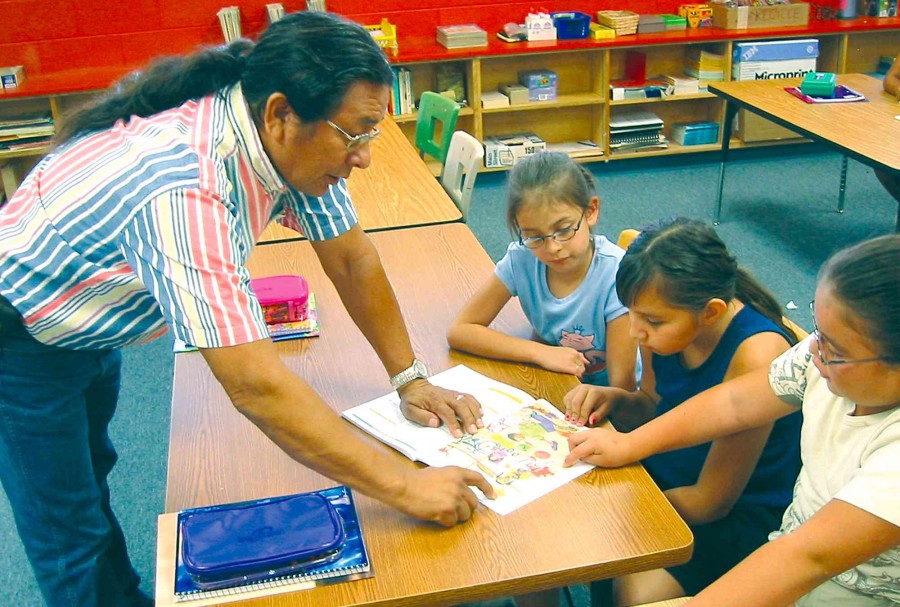 |
| Red Cloud Elementary School teacher Fred Stands helps third-graders learn Lakota. |
Albert White Hat spoke Lakota for the first 16 years of his life, but that ended the day he walked into the Jesuit-run boarding school in St. Francis on the Rosebud Indian Reservation. “I came from a community where we sang and danced and did everything in our language,” White Hat recalls. “I walked in that institution and my peers were making fun of us, the ones from the country, for being big Indians, savages. And they were all Indian kids. Many years later I found out they had been in that institution since they were 5. By the time they were teenagers they were conditioned to deny their Indian heritage.”
That was in the early 1950s, the decade in which the Lakota language began disappearing. Today just 14 percent of Indians living on reservations in North Dakota and South Dakota speak Lakota, according to 2000 census figures. And estimates suggest the number has dropped another 25 percent in the last eight years.
Lakota’s official status is “endangered,” according to David Rood, a professor and linguist at the University of Colorado in Boulder and the country’s leading Lakota scholar. There are between 8,000 and 9,000 speakers, but they are growing older. In 1993 the average age of Lakota speakers was about 50. Today it is 65. In those 18 years, fewer children learned Lakota. When fluent elders die, there are no speakers to replace them. “The transmission is broken,” Rood says.
That perilous situation has prompted a movement to create a new generation of Lakota speakers. In South Dakota, Lakota is spoken by seven tribes who live on the Pine Ridge, Rosebud, Cheyenne River, Standing Rock and Lower Brule reservations. Dakota, which is closely related to Lakota, is spoken on East River reservations and is split into two dialects – Santee (Sisseton) and Yankton. Most serious preservation efforts occurred in the last 15 years. In the 1990s several tribal councils adopted resolutions declaring Lakota their official language and required schools to teach it. But White Hat has been trying to save the language for nearly 60 years.
He was raised at Spring Creek, a small community of five or six families on the Rosebud. Children learned Lakota ways, and spent winter evenings listening to storytellers explain Lakota history, culture and spirituality using the Lakota language. But in the early 1950s the tribe adopted the state’s education standards, which said nothing about Lakota studies. When his children started school in the Todd County district in the late 1960s, White Hat lobbied for a Lakota language and history program.
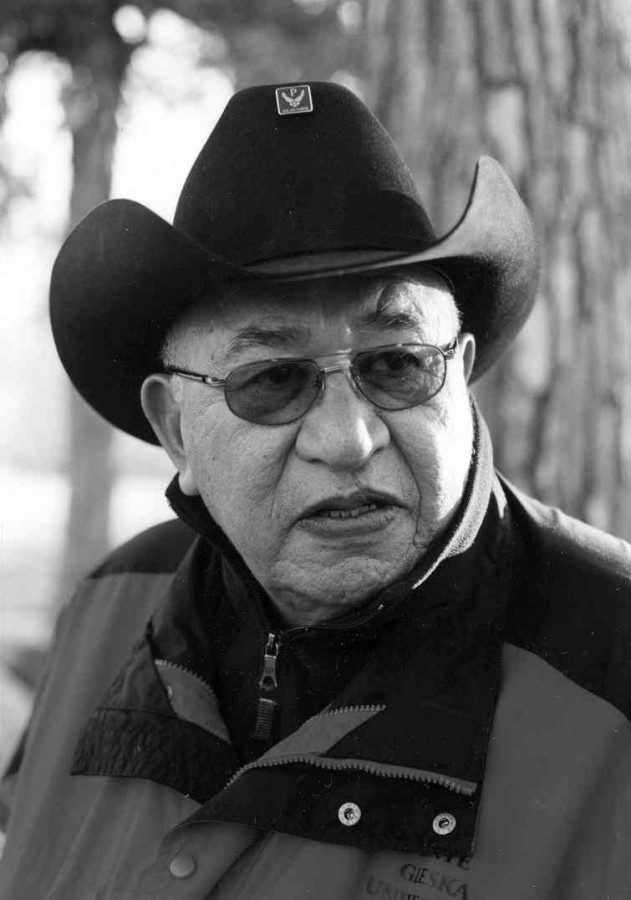 |
| Albert White Hat, Lakota speaker and instructor. |
“They really gave me a bad time,” he says. “None of them would accept it. They laughed at me. Finally in 1970, they said, ‘You can have a half an hour during noon hour to play your tape and dance.’”
Soon White Hat was teaching Lakota studies part time at St. Francis and Sinte Gleska University, which opened in 1971, even though he knew little about teaching. He had no books and learned how to formulate lesson plans from colleagues. The university hired him full time in 1983.
The Lakota Language Consortium’s goal is to make children on Dakota reservations fluent in Lakota by eighth grade. The consortium, headquartered at the University of Indiana, formed in 2004 when schools on the Pine Ridge reservation teamed with the university to preserve Lakota. The organization helps train teachers and provides textbooks, materials and assessment. The immediate focus is on Native children, but they also work with schools in Rapid City and Sioux Falls. Executive director Wilhelm Meya hopes it fosters reconciliation.
“A lot of people over the last 30 or 40 years have been going through the schools and coming out when they’re 18 and not knowing the language. And they’re very disappointed about that,” says Meya, a native of Austria who became the first non-Indian to earn a Lakota studies degree at Oglala Lakota College. “They’ve been told every day to be proud to be Lakota, but no one ever taught them to speak it. So there’s a frustration there.”
There are plenty of children to teach. Lakota and Dakota people are among the fastest growing populations in the country. In 2000 the population was around 100,000 with half under 18, and it could reach 160,000 by 2025.
In addition to textbooks, the consortium produces audio CDs and flash cards. Staff test more than 6,000 children every fall and spring and monitor progress by reading reports from people like Sacheen Whitetail Cross, tribal education manager for the Standing Rock Sioux Tribe.
Standing Rock plunged into a language revitalization program in 2007. The tribe spent $108,000 on teaching materials for six of the reservation’s nine public, grant and parochial schools and organized the first Lakota Summer Institute, a three-week course in which K-12 Lakota teachers learn new activities and methods.
Whitetail Cross organizes the institute and keeps tabs on students. She’s also developing Lakota language games. “I get so excited when I see kids speaking,” she says. “Right now it’s mostly high school students, but I can’t wait to see the young ones begin to use it. It is going to be so empowering to them.”
Revitalization is important on all reservations, but particularly on Standing Rock. Only 13 percent of its residents speak Lakota, the second lowest of South Dakota’s West River reservations behind Lower Brule (4 percent). Cheyenne River has 18 percent, followed by Rosebud (21 percent) and Pine Ridge (26 percent).
Fewer people on East River reservations speak Dakota. The Lake Traverse reservation has just 6 percent, Yankton 10 percent and Crow Creek 12 percent. Diane Merrick, a teacher at Marty Indian School and Ihanktonwan Community College on the Yankton reservation, says most Dakota speakers there (a little over 200 people) have limited knowledge of the language. She estimates only 28 people on the reservation are fluent.
“You get a little excited and nervous,” Merrick says about her language’s tenuous situation. “Language is very central to who we are. It’s a part of our cultural identity. Reaching out in any way we can with our language is very important.”
Merrick coordinates the Dakota language program at Marty and has taught at the college for 12 years, though she never planned on teaching. She has a degree in alcohol and drug abuse studies, but because she is one of the few remaining fluent Dakota speakers in the area, the college asked if she would teach the language. Merrick grew up in a traditional Dakota family on the reservation. Dakota was her first language until her family moved to Yankton when she was 6. She also offers online Dakota language lessons through the Native American Community Women’s Resource Center in Lake Andes (www.nativeshop.org).
Her main focus is teaching elementary students. Every day, students in kindergarten through fifth grade receive a 30-minute language lesson that covers basics like colors, days of the week and months. There is also a morning meditation, flag song and greeting. During the summer Merrick leads an immersion school for children ages 3 to 5. When those children enter Marty elementary, they are a step ahead. “We have a lot of hope that those are the kids who will work toward fluency,” she says.
"I came from a community where we sang and danced and did everything in our language. I walked in that institution and my peers were making fun of us, the ones from the country, for being big Indians, savages."
Parents are appreciative and often motivated to learn Dakota by enrolling in her college-level Dakota classes. “Many times students will say they just need the four credits to graduate,” Merrick says. “More and more the students are parents and young people who really want to learn their language. It’s important to them.”
In addition to tribal efforts, Leonard Little Finger hopes students will soon attend his private Lakota language immersion school near Oglala on the Pine Ridge reservation. Little Finger dedicated the Sacred Hoop School (Cangleska Wakan Owayawa) last summer.
“It’s a dedication to the ancestry that I come from,” says Little Finger, a co-founder of the Lakota Language Consortium. “It also honors my heritage.” Little Finger’s great-great-grandfather was Chief Big Foot, a signer of the 1868 Fort Laramie Treaty and leader of the band killed at the Wounded Knee Massacre in December 1890. His grandfather, John Little Finger, survived the massacre by hiding in a ravine. He settled on land where the Sacred Hoop School now stands.
Little Finger grew up on Pine Ridge. He left to attend school and work for the Indian Health Service in Aberdeen, but he returned after the 1973 Wounded Knee occupation. “Nobody wanted to come down to Pine Ridge as an administrator,” he says. “I was from there, and my folks still lived there, so I decided to come back.”
After he retired in 1995, Little Finger joined the language revitalization movement. “Since my first language was Lakota, I felt that whatever years were left of my life I would spend teaching in a regular school,” he says. “But I found that the type of teaching that was needed to transfer a language was not possible, particularly because of the No Child Left Behind Act. So reluctantly I had to go on a private basis.”
He raised money to build the school with help from German musician Peter Maffay and Apache singer Robby Romero. Mission of Love, a Youngstown, Ohio, organization dedicated to helping the world’s poorest regions, gathered discounted or donated building materials.
Lakota has been spoken by people in North America for over 3,000 years. When the Pilgrims arrived in 1620, hundreds of Native languages flourished across the continent. Only a dozen, including Lakota, survived the westward European advancement and are considered viable today. Studies show that starting in 1954 more Lakota children learned English as a first language than Lakota. “Something happened in that post war era that convinced enough parents that there was no future in getting the kids to speak Lakota,” Meya says.
The federal government is partly to blame. During the 1950s the government reversed its Indian policy. After 20 years of measures designed to let Indians plot their own futures, highlighted by the Indian Reorganization Act of 1934, the Eisenhower administration adopted a termination policy. The government sought to end tribal benefits while assimilating Indians into white society. “It was acceptable to say, ‘We live in an English-speaking world. We might as well join,’” Little Finger says. “That was the frame of mind that young parents were picking up.”
As teachers try to restore Lakota’s vitality, they are fortunate that the language is fairly easy to pick up. Meya says it’s straightforward and sounds like German and Slavic languages, which could explain its popularity in Europe. “Lakota is something that people who like to learn languages find relatively easy to learn,” Meya says. “There’s great worldwide interest in the language, and that helps support it. In terms of international use of any Native American language, it is the language that most people want to learn, and we like to encourage that.”
The Lakota alphabet includes 25 characters and 14 digraphs, which are two-letter combinations that represent specific sounds. Linguist Rood calls Lakota a “verb last” language, meaning the sentence structure follows a subject-object-verb pattern. The language has other unique characteristics. The speaker’s gender determines what words are used. Instead of voice inflections, speakers use words at the ends of sentences to convey emotions. “The difference between surprise and disgust, anger or conciliation, is expressed with actual words,” Rood says. “I’ve got a list of about 30 of those words. I keep finding more of them all the time.”
In 1976 Rood co-wrote the first college level Lakota language textbook, Beginning Lakhota. His book is still widely used because in the last 30 years, few new reference books have appeared. “The stumbling block has always been that there is no standard writing system,” Rood says. “Everybody makes up their own system based on what they’ve heard or seen in religious materials, or what they think they should do because they know how to write English.”
Albert White Hat has worked on standardization since 1973, but he encountered problems in the 1990s as he worked on his textbook, Reading and Writing the Lakota Language. White Hat and Jael Kampfe, a Montana native studying at Yale University, began the project in 1992. Kampfe recorded White Hat’s classes. Then they transcribed and edited them into a 226-page book. He sent the manuscript to three linguists and a host of schools and publishers who offered mixed reviews.
“The language has developed what they call a subculture,” White Hat explains. “Historians and anthropologists use the modern translations, and my work contradicts that. They didn’t want that printed.” One major university press told White Hat that, “folk etymology and oral history are fine, but they’re not recorded so this shouldn’t be printed.” The University of Utah Press finally published his book in 1999 and is widely used.
The Lakota Language Consortium took a major step in standardizing Lakota writing with its New Lakota Dictionary. It contains 20,000 words and definitions, including over 6,000 words that have never appeared in a dictionary, and a 90-page section on grammar. The 3,000 “most important” words are highlighted. The book’s introduction discusses the history of the language and lexicography.
Work on the dictionary began in 1985. Its authors consulted over 300 Lakota and Dakota speakers in South Dakota and Minnesota. It is the culmination of nearly 180 years’ worth of efforts to compile Lakota language reference works. The first attempt came from missionary brothers Samuel and Gideon Pond, who collected words among the Santee people in Minnesota in the 1830s. In 1852, missionary Stephen Riggs edited the Grammar and Dictionary of the Dakota Language, and 40 years later, published the Dakota-English Dictionary. John P. Williamson published an English-Dakota dictionary, meant to be a companion to Riggs’ earlier work, in 1902.
Other dictionaries followed in the 20th century. These, and the earlier works, all had faults. In some cases authors simply took words from English dictionaries and had Indians translate them. That process was hit-and-miss because some English words have no Lakota equivalent, resulting in new Lakota words created specifically for the dictionary. Another problem was that authors failed to distinguish between such nuances as aspirated and hard stops, which hindered written development of the language.
South Dakota native Ella Deloria did some of the best work. Growing up on the Yankton and Standing Rock reservations, Deloria learned Lakota and the Yankton dialect of Dakota. She developed a deep appreciation for her language. “The [languages] I know are rich and full of vitality, picturesque, laconic, and capable of subtle shades of meaning,” she wrote in her 1944 book Speaking of Indians. “It was a white man’s joke, now worn rather thin, that all an Indian could do to express himself was to grunt. ‘Ugh!’ was supposed to be his whole vocabulary. But the opposite is true.”
Deloria immersed herself in the language. She spent decades translating old books and meticulously cataloging Lakota and Dakota words. “I have amassed so many words in the Dakota dialects – Yankton, Santee, Teton and Assiniboin – that I despair of ever classifying them and making them available for the use of study in linguistics,” she lamented. But in 1941 she collaborated with renowned linguist Franz Boas on the most complete Lakota grammar to date. And after she died in 1971, Deloria’s linguistic gold mine became the foundation for books like Professor Rood’s Beginning Lakhota and the New Lakota Dictionary.
Thousands of Lakota youth use the dictionary and materials from the Lakota Language Consortium every day. Educators hope they help streamline Lakota language instruction. If they’re right, with help from dedicated teachers like Albert White Hat and Leonard Little Finger the language should be safe for generations.
Lakota on the Air
Educators use more than books to teach Lakota. Graduate students at the University of Colorado are producing videos of Lakota speakers to capture their conversational style. The students then translate, mark sentences for grammar and upload the videos to a computer.
The conversational style is “the least well documented” aspect of Lakota, says Professor David Rood, a linguist at the university. “We’ve got lots of formal language. We’ve got speeches, prayers, traditional stories and biographies in written form, but nobody has ever actually paid attention to the way in which people take turns when they’re talking, or how they interrupt someone politely. That’s part of actually using the language every day.”
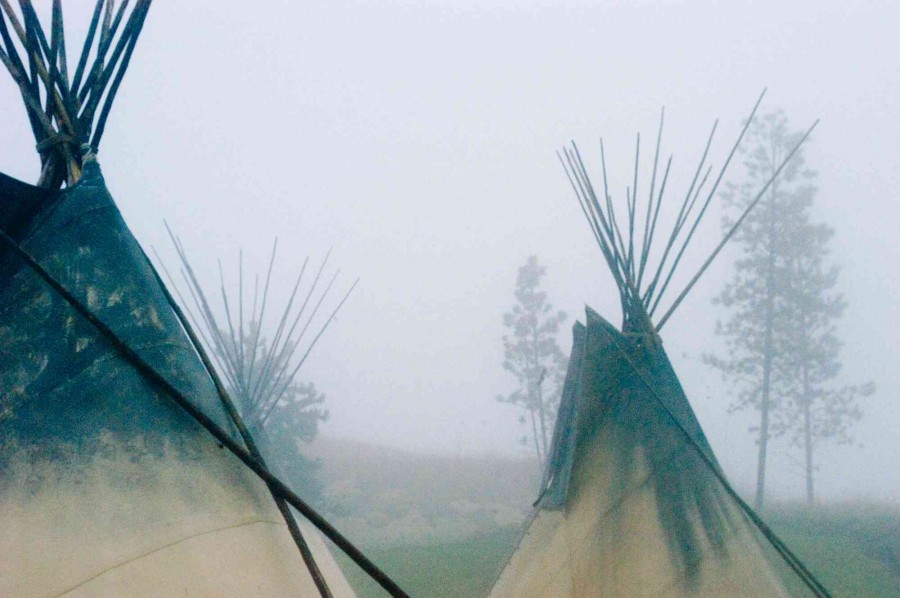 |
In Pine Ridge, Bryan Charging Cloud and his cousin, Robert Two Crow, host a Lakota language show on KILI Radio. “We spoke Lakota about anything, just as long as we used the language,” Charging Cloud says. The show, which airs from 8-9 a.m. (MST) Saturdays, has evolved to include lessons, stories and discussions about the language. Two years ago he added a storytelling hour that airs Wednesdays at 5 p.m.
“These shows are good for people who just want to listen and learn,” says Charging Cloud, who directs the Lakota Language Institute at Oglala Lakota College and leads an immersion program for young children. “A long time ago Lakota people used to tell stories at night. Not too many people speak Lakota now, so they probably don’t do that. We just carry that on.”
Charging Cloud also produces a Lakota language television program for the college’s local channel and has used video conferencing and e-mail to teach students at places like Stanford University in California. Listeners can hear Charging Cloud’s shows at 90.1 FM or online at www.kiliradio.org.
Editor’s Note: This story is revised from the March/April 2009 issue of South Dakota Magazine. To order a copy or to subscribe, call 800-456-5117.

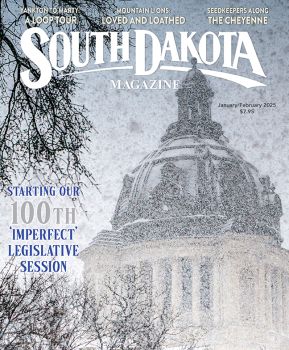
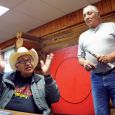
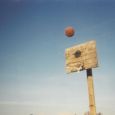
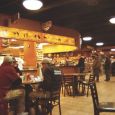
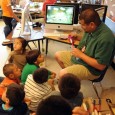
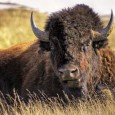
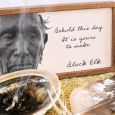
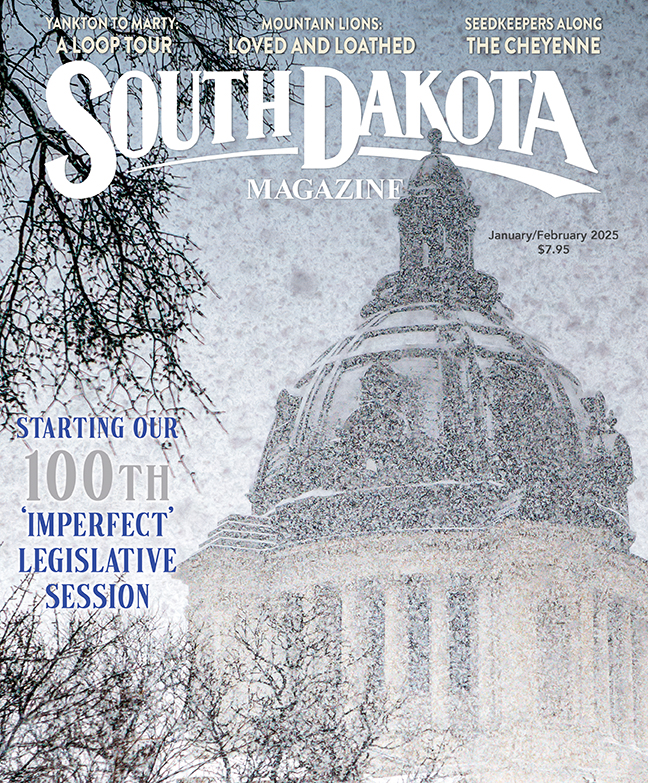

Comments
The Two Scout story and realization of the duality of man and women to live accordingly in our physical being and choices in life. To live holistically. Tawacin, cante, tacan na nagi untawa wakan, iyokipi, iyuskinyan na wasteya hecase unni uncinpelo.
lTetonwan Oyate hecumse Wakan Tanka unkagayelo. Ospaye Sakowin na lakolyakel wicoiayapi unhapelo. Gluspapo heca tanyan unnipi kte lo.